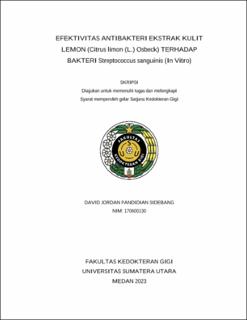Efektivitas Antibakteri Ekstrak Kulit Lemon (Citrus limon (L.) Osbeck) terhadap Bakteri Streptococcus sanguinis (In Vitro)

Date
2023Author
Sidebang, David Jordan Pandidian
Advisor(s)
Zulkarnain
Metadata
Show full item recordAbstract
Periodontal disease is a disease of the oral cavity which ranks first in the world record books in 2001 as the most common disease in humans. Streptococcus sanguinis are the first bacteria to come into contact with the pellicle on the tooth enamel surface and act as an inducer in the process of dental plaque formation. lemon zest (Citrus limon (L.) Osbeck) has antibacterial properties such as flavonoids, tannins, steroids, and triterpenoid saponins which can inhibit bacterial growth. This study aims to determine the effectiveness of lemon peel extract with a concentration of 25%; 12.5%; 6.25%; and 3.125% to growth Streptococcus sanguinis ATCC® 10556™.
This type of research is a laboratory experimental research design post test only control group, consisting of 6 groups with 4 repetitions of groups. Tests in this study used the disc diffusion method to determine the inhibition zone and the minimum inhibitory concentration (MIC) was measured using a caliper and the dilution method to determine the minimum killing rate (MBC) by counting the number of colonies using a computer. Lemon peel was extracted by maceration method using 70% ethanol solvent, 6 treatments were carried out with 25% concentration; 12.5%; 6.25%; and 3.125%. The positive control used Chlorhexidine 0.2% (Minosep®) and the negative control used DMSO.
Inhibition zone research results at a concentration of 25%; 12.5%; 6.25%; and 3.125% with an average of 9.00mm; 8.55mm; 7.55mm; 7.15mm; results of the calculation of the number of colonies in the 25% concentration group; 12.5%; 6.25%; 3.125%; Minosep®.; dan DMSO yaitu 979,25 CFU/ml, 1337,25 CFU/ml, 1865,25 CFU/ml, 1971,25 CFU/ml, 0,00 CFU/ml, dan 2812,75 CFU/ml.
It was concluded that lemon peel extract has antibacterial activity in inhibiting bacterial growth Streptococcus sanguins. The largest diameter of the inhibition zone was at a concentration of 25% with an average of 9.00mm. The MIC value at a concentration of 3.125% with an average of 7.15 mm and the MBC value cannot be determined.
Collections
- Undergraduate Theses [1901]
